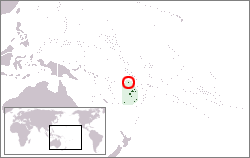
Rotuma is a self-governing heptarchy, generally designated a dependency of Fiji. 'Rotuma' commonly refers to Rotuma Island, the only permanently inhabited and by far the largest of all the islands in the Rotuma Group. Officially, the Rotuma Act declares that Rotuma consists of Rotuma Island as well as its neighbouring islands, rocks, and reefs across the entire Rotuma Group. The dependency is situated around 500 km west of the French islands of Wallis and Futuna and a similar distance north of the Fijian mainland. Its capital is Ahau, a hamlet consisting of a number of colonial-era buildings. Rotuma exists as a dependency of Fiji but itself contains its own socioreligious pene-enclave known traditionally as Faguta where the chiefs and their villages adhere to the practices of worship, festival dates, and French-based writing system of the Marists. Faguta's special character was effectively agreed to by all Rotuma's chiefs in 1871 in the Treaty of Hamelin.
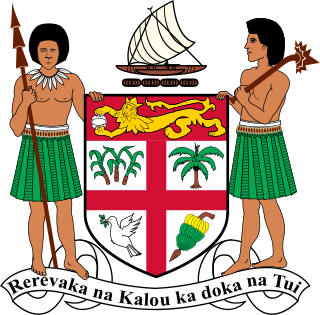
Fiji is divided administratively into four divisions, which are further subdivided into fourteen provinces. Each province has a provincial council.
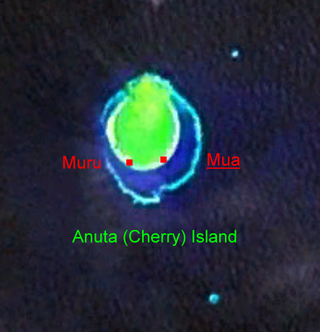
Anuta is a small volcanic island in the southeastern part of the Solomon Islands province of Temotu, one of the smallest permanently inhabited Polynesian islands. It is one of the Polynesian Outlier communities in Melanesia.
The Council of Rotuma is a municipal body on the island of Rotuma, a Fijian dependency. Owing to the unique character of Rotuma, the powers of this council are greater than those of other municipal bodies in Fiji and in some ways it approximates a legislative body, though it is in every way subordinate to the Parliament of Fiji.

Wallis is a Polynesian atoll/island in the Pacific Ocean belonging to the French overseas collectivity of Wallis and Futuna. It lies north of Tonga, northeast of Fiji, east-northeast of the Hoorn Islands, east of Fiji's Rotuma, southeast of Tuvalu, southwest of Tokelau and west of Samoa. Its area is almost 100 km2 (39 sq mi) with 8,333 people. Its capital is Mata Utu. Roman Catholicism is the predominant religion. Its highest point is Mount Lulu Fakahega. Wallis is of volcanic origin with fertile soil and some remaining lakes. Rainfall is plentiful.
Solkope is a small and densely wooded island off the southern coast of Rotuma in the Fiji Islands, at the edge of the fringing coral reef. It is separated from the main island of Rotuma by a channel that is between 50 and 200 m wide, and lies immediately southeast of the village of Kalvaka in the district of Noaʻtau. It 765 m long east–west, and up to 515 m wide, and rises to a height of 128 m. Its area is 0.3 km2. From the sea, it cannot be recognised as a separate island.
There are three confederacies in the Fijian Traditional Government, Kubuna, Tovata and Burebasaga. One of the two Paramount chiefly tribes in the Kubuna Confederacy is the "ToraniBau" the other
The Rotuma Group is a group of volcanic islands, with Rotuma Island being the main island, located at 12°35′S177°10′E, approximately 465 km north of Fiji.
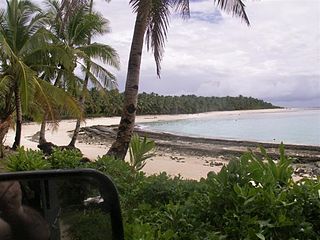
Motusa is a group of close villages in the district of Itu'tiu, on the island of Rotuma, one of the islands of Fiji. Rotuma is made up of two volcanic landmasses connected by a sandy isthmus, on which Motusa is located. For this reason it has one of the islands longest white sandy beach. Motusa also sits between the Islands two largest bay; Maka Bay to the North and Hapmafau Bay to the South.
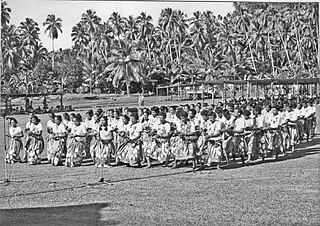
Dance in Rotuma refers to the traditional and modern dance styles performed by the people of the island of Rotuma, which became a dependency of Fiji in 1881. Despite Rotuma's political and historical links with Fiji, the island's culture shows strong Polynesian influences, particularly from Samoa and Tonga, which, along with Fiji, feature strongly in the history and traditions of the Rotuman people.
Sau,, refers to the role of spiritual leader in pre-Christian Rotuman society. The title was neither primogenitary nor held for a lifetime, but rather was cycled through the chiefs of each of Rotuma's districts.
Gagaja is a Rotuman word denoting the position of "Chief" or "Lord". This could be a formal chiefly position in one of the seven districts or a village chief as well as to anyone else, such as the Chairman of the Rotuma Island Council to whom respect and deference is owed based on their own skills and attributes. Unlike in many other Pacific cultures, the official chiefly positions are not allocated according to any strict primogeniture, but rather are elected from all eligible males within certain kạinaga to whom the chiefly title belongs.
The fakpure was the secular ruler of Rotuma in the pre-European contact times. It was one of three chiefly roles with direct influence across the island of Rotuma, the other two being the mua and the sau. Traditionally the most senior political authority on the island, the fakpure was one of the gagaj ‘es itu’u of the districts of Rotuma, and the convener of the island’s Council of Chiefs. After being elected as the district chief through the traditional processes, the position of fakpure was bestowed on the most senior of these district chiefs, usually the chief whose district had won the most recent war, who also received the privilege of being the first served in the politically charged kava ceremony.
The Rotumans are a Polynesian ethnic group native to Rotuma, an island group forming part of Fiji. The island itself is a cultural melting pot at the crossroads of the Micronesian, Melanesian and Polynesian divisions of the Pacific Ocean, and due to the seafaring nature of traditional Pacific cultures, the indigenous Rotuman have adopted or share many aspects of its multifaceted culture with its Melanesian, Micronesian and Polynesian neighbours.

Severe Tropical Cyclone Daman was the strongest cyclone of the 2007–08 South Pacific cyclone season. Cyclone Daman was the fourth tropical depression and the first severe tropical cyclone to form east of longitude 180° during the 2007–08 South Pacific cyclone season. Due to the severity of the storm, the name Daman was retired and replaced with Denia.

Uea is a high rocky offshore island of Rotuma. Uea is one of a number of outliers lying off the west coast of Rotuma. It is the second largest island and is the highest island in the Rotuma Group with an elevation of 260 metres (850 ft).
Mua people (Mualgal) alternatively the Moa, are an Indigenous Australian Torres Strait Island people based on Moa. According to Alfred Cort Haddon their lifestyle, culture, myths and kinship networks overlapped closely with those of the Kaurareg on neighbouring Muralag, while also forming an integral part, linguistically and culturally, with all Western and Central Island peoples of Torres Strait.

Solnohu or Sol Nohu, also known as Solnoho, Solnahu and Solnahou, is a small crescent-shaped uninhabited island in the Rotuma Group of Fiji. The island is of special importance in Rotuman and Tongan funerary customs.
Rotuman New Zealanders are Rotuman immigrants in New Zealand, typically from Rotuma Island or Fiji, their descendants, and New Zealanders of Rotuman ethnic descent. At the time of the 2018 New Zealand census, 981 people in New Zealand were surveyed as being of Rotuman descent.







